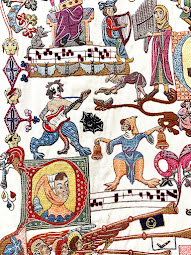Despite the hot weather, we were all pleased to be back at Harrogate Creative Stitchers today after our summer break! During the morning session, members brought along their own stitching and had a good catch up. At midday our annual general meeting commenced and members were re-elected. We said thank you to long serving member Irene Earl who has served as our treasurer most recently and is now stepping down. Lorna, Irene and Sue gave a summary of the year to date, summarising wonderful speakers and workshops, lots of new members joining and a full programme of events to come.
After lunch we were delighted to
welcome Tanya Bentham who is renowned for her superb medieval
embroidery. She works in traditional
methods and medieval materials but more
latterly has added her own modern twist!
She prefers to use her own hand dyed wools where possible because of the
quality of the colours and it is in keeping with this era. Her work is inspired by historic textiles and
manuscripts. She has won “Innovative use
of Textiles” at the Fine Art Textiles Awards in 2022 and has written two books
(so far), Opus Anglicanum (2021) and Bayeux Stitch (2022). Tanya’s energy and enthusiasm for her craft
as well as her sense of humour, were to make a very enjoyable afternoon!
Tanya
started by showing us her traditional work in Bayeux stitch which is a type of
couching technique performed over a layer of laid threads covering the ground. She also uses stem, chain and split stitch
and talked about her use of convent stitch in a kit which she has created of a ‘Penis
picking nun’ harvesting willies from an oak tree! An example of Tanya’s humour
showing through in her work often inspired by folk stories or historic imagery. This led her to create the ‘Naughty kits pdf
pattern book’ which is available on her website!
Tanya then showed us three panels of a series of six called ‘Luttrell Fantasies’ inspired by Luttrell Psalter’s Illuminated Manuscripts which have a definite Tanya twist! Her style has developed as she has gone along, with the first hanging having more negative space which in hindsight she is not so keen on. In the second ‘dragon’ hanging there is a lot more going on and she is playing with how characters and animals interact with each other. The third ‘music’ hanging is great fun, in which at first glance you might not notice modern references to and faces of artists such as Bowie, Meatloaf and Nirvana.
The technique
of Opus Anglicanum was spoken about very passionately by Tanya and why she
thinks it should be celebrated and revived.
Opus Anglicanum is Latin for ‘English Work’ first coined in the 13th
century to describe the highly prized and luxurious embroideries made in England
of silk, gold and silver thread. They
depict elaborate imagery in detailed stitch such as the Toledo Cope at the V
& A and were often given as diplomatic gifts. There are little remaining examples of this
type of work because of the Reformation in the 16th century. Tanya went onto explain how the use of
specific thread i.e. filament silk which lies flat and should be packed and grouped
together in such a way that no individual stitches can be seen so that the
light reflects in a certain way giving a special kind of sheen or ‘glow’ as
Tanya describes it. Tanya showed some exquisite
examples of her work, particular in her depiction of faces and how they are
made of swirls in geometric shapes, all in one colour and then letting the light
do the work, the stitches flowing together.
It was an incredible talk and Tanya really is a character and so interesting. After the presentation we were able to chat to her
about her work, much of which was on display. We were also able to browse and buy her beautiful,
fun and some ‘naughty’ embroidery kits.
Thank you Tanya, it was really interesting and lots of fun listening to
you, thank you for starting our year off with a bang!
For more
information on Tanya’s work visit https://www.opusanglicanumembroidery.com/
or visit her blog at https://opusanglicanum.wordpress.com/
. She is on Instagram also at @opusanglicanum
and runs an Opus Anglicanum medieval embroidery group on Facebook.











Comments
Post a Comment